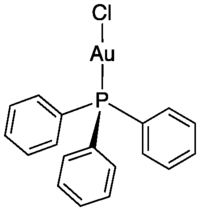Chloro(triphenylphosphine)gold(I)
 | |
gold(I)-3D-spacefill.png) | |
| Identifiers | |
|---|---|
3D model (JSmol) |
|
| ChemSpider | |
| EC Number | 238-117-6 |
PubChem CID |
|
| |
| |
| Properties | |
| C18H15AuClP | |
| Molar mass | 494.71 g·mol−1 |
| Appearance | Colorless solid |
| Density | 1.97 g/cm3 |
| Melting point | 236–237 °C (457–459 °F; 509–510 K) |
| Hazards | |
| GHS pictograms |  |
| GHS signal word | Warning |
| H315, H319, H335 | |
| P261, P264, P271, P280, P302+352, P304+340, P305+351+338, P312, P321, P332+313, P337+313, P362, P403+233, P405, P501 | |
Except where otherwise noted, data are given for materials in their standard state (at 25 °C [77 °F], 100 kPa). | |
| Infobox references | |
Chloro(triphenylphosphine)gold(I) is the coordination complex with the formula (Ph3P)AuCl. This colorless solid is a common reagent for research on gold compounds.
Preparation and structure
The complex is prepared by reducing chloroauric acid with triphenylphosphine in 95% ethanol:[1][2]
- HAuCl4 + H2O + 2 PPh3 → (Ph3P)AuCl + Ph3PO + 3 HCl
The complex adopts a linear coordination geometry, which is typical of most gold(I) compounds.[3] It crystallizes in the orthorhombic space group P212121 with a = 12.300(4) Å, b = 13.084(4) Å, c = 10.170(3) Å with Z = 4 formula units per unit cell. [4]
Reactivity
Many related, charge-neutral gold complexes (often incorrectly called salts) are known. These including the trifluoromethanesulfonate and the nitrate derivatives of chloro(triphenylphosphine)gold(I).[5] Triphenylphosphine gold triflate (Ph3PAuOTf) catalyzes certain rearrangement reactions of interest in organic synthesis. Another popular Au(I) reagent is AuCl(THT), where THT = tetrahydrothiophene.[6]
_and_gold(III)_organometallic_compounds.png)
References
- ↑ Pierre Braunstein, Hans Lehner, Dominique Matt "A Platinum-Gold Cluster: Chloro-1κCl-Bis(Triethylphosphine-1κP)Bis(Triphenylphosphine)-2κP, 3κP-Triangulo- Digold-Platinum(1 +) Trifluoromethanesulfonate" Inorganic Syntheses, 1990, Volume 27, Pages 218–221. doi: 10.1002/9780470132586.ch42
- ↑ M. I. Bruce, B. K. Nicholson, O. Bin Shawkataly (1989). "Synthesis of Gold-Containing Mixed-Metal Cluster Complexes". Inorganic Syntheses. 26: 324–328. doi:10.1002/9780470132579.ch59.
- ↑ Baenziger, N. C.; Bennett, W. E.; Soborofe, D. M. (1976). "Chloro(triphenylphosphine)gold(I)". Acta Crystallographica Section B. 32 (3): 962. doi:10.1107/S0567740876004330.
- ↑ Borissova, Alexandra O.; Korlyukov, Alexander A.; Antipin, Mikhail Yu.; Lyssenko, Konstantin A. (2008). "Estimation of Dissociation Energy in Donor−Acceptor Complex AuCl·PPh3via Topological Analysis of the Experimental Electron Density Distribution Function". The Journal of Physical Chemistry A. 112 (46): 11519–22. doi:10.1021/jp807258d. PMID 18959385.
- ↑ A. M. Mueting, B. D. Alexander, P. D. Boyle, A. L. Casalnuovo, L. N. Ito, B. J. Johnson, L. H. Pignolet "Mixed-Metal-Gold Phosphine Cluster Compounds" Inorganic Syntheses, 1992, Volume 29, Pages 279–298, 2007. doi:10.1002/9780470132609.ch63
- ↑ Rafael Uson, Antonio Laguna, Mariano Laguna (1989). "(Tetrahydrothiophene)Gold(I) or Gold(III) Complexes". Inorganic Syntheses. 26: 85–91. doi:10.1002/9780470132579.ch17.